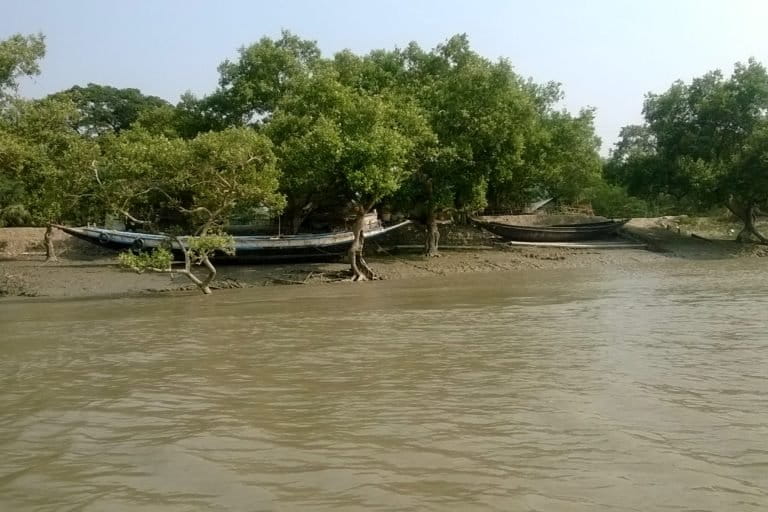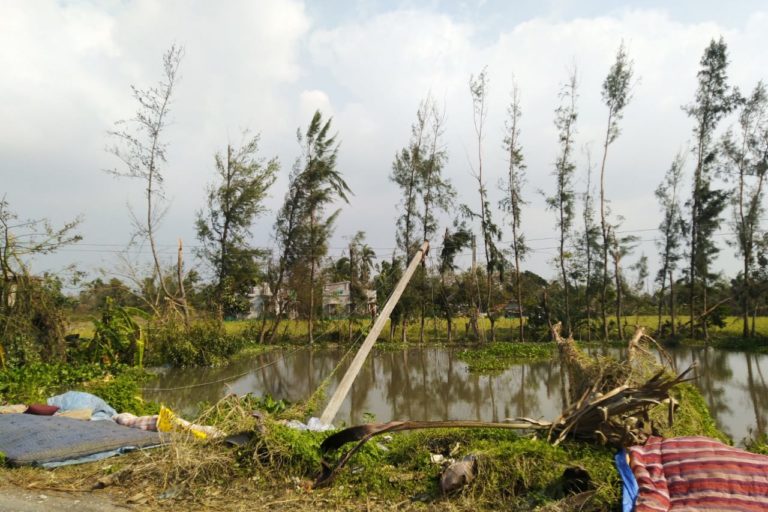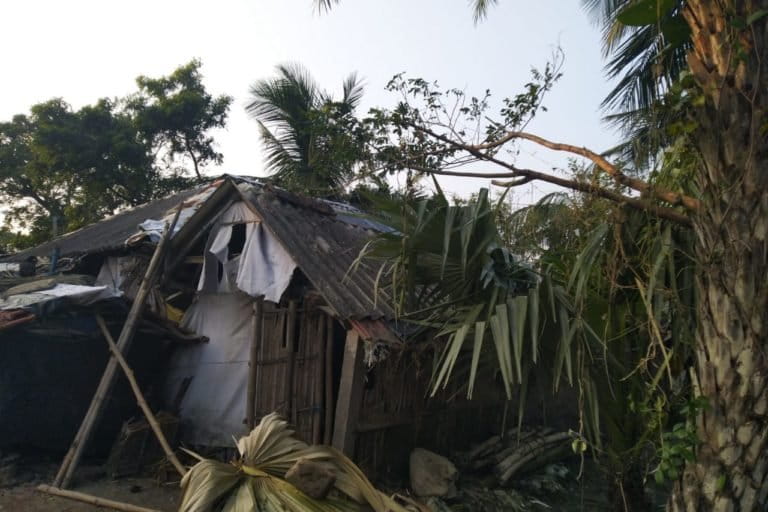- Bulbul, one of the recent tropical cyclones, wreaked havoc in southern West Bengal and parts of Odisha in November 2019, triggering the loss of billions of rupees.
- In this commentary, researchers from IIT Kharagpur recount their experiences of travelling in the Sundarbans.
- The researchers talk of the importance of mangroves as a source of resilience against climatic vulnerability.
- They also make a case for taking into account indigenous knowledge in forest management.
Bulbul, one of the most recent tropical cyclonic storms, wreaked havoc in southern West Bengal along with parts of Odisha on 8th and 9th November 2019. The storm is said to have triggered losses between 15,000 and 19, 000 crores, as per official projections.
The storm surges primarily affected the districts of North and South Parganas and East Midnapore in West Bengal, claiming several lives, destroying houses, physical assets and sweeping away ripe agricultural harvests. Despite the adequacy of pre-arranged assistance, reliefs and contingencies provisioned by the state, Bulbul led to significant devastations for marginal rural communities in the districts — primarily subsistence agriculturalists.
Sundarbans are shared between India and Bangladesh. Parts of the Sundarbans Delta, the largest contiguous stretch of riverine mangrove forests globally, are located in the districts of North and South 24 Parganas in West Bengal.
An extensive archipelago situated between the vast Indian Ocean to the south and the fertile plains of Bengal to the north, the Sundarbans is created by the confluence of the Ganges, Meghna and Brahmaputra rivers.

Although there have been tangible losses to lives and assets in the Sundarban region, it has been palpably witnessed how the mangrove ecology naturally safeguarded people and the inland against the severe storm surges of Bulbul.
Pneumatophores, a halophytic shrub variety which predominates in coastal mangrove forests, have extended prop-roots which stabilize the soil and protects land from strong tidal waves. Mangroves also reduce the wind speed, by attenuating the energy of the wind while passing through the dense tree cover. They act as natural buffers between the land and the sea, and apart from sequestering carbon, they also shield against riverbank erosion by stabilizing soil and sediments through organic depositions.
Mangroves safeguard low-lying land near coasts by checking excess salt deposition from storm surges and flooding. Despite extensive devastations in several blocks of the Indian Sundarbans like Sagar, Gosaba, Namkhana, Patharpratima, Basirhat and Kakdwip, experts have predicted that damages could have been worse, since the wind speed was 135 km/hour, more than the super-cyclone Aila, which devastated the Sundarbans Delta in 2009. Moderately lesser devastation by Bulbul has also been attributed to a timely low-tide, smaller waves and a significantly lesser inundation than that was projected.
The Sundarban mangrove cover played a primary role in resisting the storm – by reducing wind speed and breaking the waves, thus protecting the Delta as well as the city of Kolkata from greater devastations. Kolkata was anticipated to have been hit significantly severe by the cyclone. A recent story quotes views from ecologists and forest conservators to explain that the uniqueness of Sundarban mangroves primarily lies in its ability to absorb the storm steam through the impenetrably thick cluster of prop-roots, extricating the cyclone of its severest effects. Parts of the islands, where the mangrove cover is less have been found to be affected badly by the cyclone, whereas the eastern peripheries with a dense cover suffered lesser devastation.
It is evident that mangrove covers need to be generated and conserved through thoughtful and co-produced initiatives. Yet, the ways in which these fertile ecosystems are subjected to depletion is frightening. The proposed international airport at Navi Mumbai poses a threat to 110 acres of mangroves and wetlands, which protects the interior landscapes of the city from the tidal waves of the sea.
In Kerala, diversion of mangrove lands for development projects have gone unchecked- one of the major reasons which triggered the floods of 2018. The SEZ and waterfront development projects in Mundra coast, Gujarat, endangered a delicate stretch of mangroves, which had in the past abated strong cyclone surges.
Extreme climate-change events and frequent cyclones like Bulbul and Fani calls for a conscious recognition of the need of productive ecosystems like mangroves and an effective governance mechanism working towards long term environmental sustainability.
Read more: On the frontline of disasters, mangroves at the receiving end of development and climate change
Though recent media reporting has highlighted on the significance of mangroves against fatal cyclonic occurrences, yet nowhere there is mention about the fact that these are thickly inhabited by communities since historical times.

Furthermore, this ignorance also circumvents the scope of community knowledge and practices in mangrove protection. Community forest management practices can be integrally linked to mangrove conservation programmes. Our past and ongoing field observations from Sundarbans reveal that community knowledge is rarely pooled into formal mangrove conservation and restoration programmes. Earlier, dry fuel-wood collection by the community was a prevalent practice, which was used for cooking in village households. An absolute ban imposed by the forest department on fuel-wood collection not only affected community livelihoods but also has an adverse effect on the forest.
Due to the restriction, piles of waste dry-wood aggregate and river creeks inside the forests are getting chocked. Furthermore, forest dependents can affirm that specific cutting techniques promotes re-growth for the trees.
Nipa (Nypa fruticans) and Garjan (Rhizophora spp.), two prominent mangrove species in the Sundarbans, have stopped regenerating due to lack of shoot-cutting, the communities say.
Garjan, according to the locals, if cut well from below, develops at least four to five stilts. Nipa also needs to be cut from time to time, through brown edges of its mature branches. But forest guards do not allow this. Communities can demonstrate the greater success of trees on the inhabited islands which they cut from time to time. The former has grown well, while the closed core forest areas have transformed into hedges rather than trees. Well-maintained flowering mangrove plants would be thriving sites for honey as well, communities believe.
Ecological threats are looming large in the forms of extreme weather events like Bulbul. To cope with intensifying challenges – shrinking of landscapes, devastations of harvest yields and physical assets and loss of lives – it is imperative that an urgent attention be directed towards protecting ecologically vulnerable landscapes like mangroves. Local knowledge is evidently contextual and robust and can have significant merits in framing resilient conservation methods.
Read more about the impact of Fani on mental well-being

CITATION:
Basu, J. 2019. Bulbul could have damaged Sundarbans more than Aila but for the low tides. Down to Earth, 13th November 2019. https://scroll.in/article/926432/new-mangrove-study-shows-exactly-how-coastal-forests-protect-economic-activity-during-cyclones
Marois, D.E. and Mitsch, W.J. 2015. Coastal protection from tsunamis and cyclones provided by mangrove wetlands: a review. International Journal of Biodiversity Science, Ecosystem Service and Management, 11 (1), 71-83.
Moolna, A. 2019. New mangrove study shows exactly how coastal forests protect economic activity during cyclones. The Scroll, 9th June 2019. Available at: https://scroll.in/article/926432/new-mangrove-study-shows-exactly-how-coastal-forests-protect-economic-activity-during-cyclones
Press Trust of India. 2019. Cyclone Bulbul: West Bengal’s losses could reach 19000 crore. India Today, 13th November, 2019. Available at https://www.indiatoday.in/india/story/cyclone-bulbul-west-bengal-s-losses-could-reach-rs-19-000-crore-1618309-2019-11-13
Thakur, J. 2019. Sunderbans shield protects Kolkata from Bulbul fury. Hindustan Times, 13th November 2019. Available at: https://www.hindustantimes.com/india-news/sunderbans-shield-protects-kolkata-from-bulbul-fury/story-jGL5lzL3kOHkeaoKmROwSN.html
The authors are assistant professors at the Department of Humanities and Social Sciences, Indian Institute of Technology Kharagpur.














